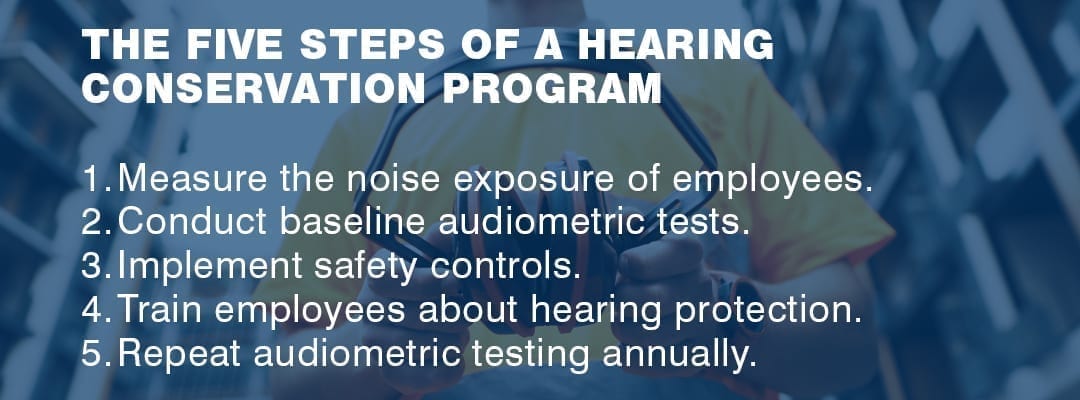
Developing a hearing conservation program is crucial for protecting your employees from noise-induced hearing loss.
Hearing loss is the most common work-related illness in the United States. And once the damage is done, hearing loss is permanent. This is unfortunate because noise-induced hearing loss is also completely preventable.
Employers have a responsibility to protect their employees from hazardous noise. Contrary to popular belief, though, it’s not just the occasional loud noise you need to worry about. If your employees are exposed to continuous noise, their hearing is at risk, too.
How to Create a Hearing Conservation Program

OSHA requires you to implement a hearing conservation program “when noise exposure is at or above 85 decibels averaged over eight working hours, or an eight-hour time-weighted average.”
Not sure if that applies to your facility? In this article, we’ll show you how to determine if you need a hearing conservation program and how to get started developing one.
If you’re wondering what a hearing conservation program includes, we’ll walk you through each of these components:
- Noise exposure testing
- Audiometric testing
- Safety controls
- Employee training
- Annual testing
To get started, you’ll need to measure each employee’s level of noise exposure.
1. Measure the noise exposure of employees
Your initial goal is to identify employees with “noise exposures equal or exceed an eight-hour time-weighted average sound level of 85 decibels.” OSHA uses this threshold to determine if you need a hearing conservation program because it reflects noise exposure during a typical workday.
Two tools are handy at this stage. First, sound level meters measure the overall noise in an environment. If you have an area of your facility with loud machinery, you can use a sound level meter to gauge the general noise level in that area throughout the day.
Noise dosimeters measure an individual’s noise exposure. An employee can wear a dosimeter on their shoulder, so you can record their varying levels of noise exposure as they move around throughout the day.
Noise dosimeters provide the more specific measurements you need to calculate eight-hour time-weighted averages for individual employees. OSHA’s formula for the time-weighted average is somewhat complex, so most dosimeters compute it for you.
OSHA 1910.95 specifies that “All continuous, intermittent and impulsive sound levels from 80 decibels to 130 decibels shall be integrated into the noise measurements.” You must also alert employees if they exceed the eight-hour time-weighted average and keep noise exposure measurement records for two years.
2. Conduct baseline audiometric tests
Once you’ve identified employees with time-weighted averages exceeding or equal to 85 decibels, OSHA requires you to provide audiometric testing to affected employees.
An audiometric exam measures a person’s ability to hear sounds. During an exam, an audiologist, otolaryngologist or physician uses an audiometer to test a person’s hearing in each ear at different frequencies — typically at 500, 1000, 2000, 3000, 4000 and 6000 Hz.
The results of audiometric testing help you establish a baseline for the employee’s hearing. Without this data, you’d have no way of knowing if your safety controls are effective.
According to OSHA, the employee must not be exposed to workplace noise for 14 hours before the test to ensure accurate results. Once complete, audiometric test records should be kept for the duration of an employee’s employment.
3. Implement safety controls
So far, you’ve measured your employees’ noise exposure, and you’ve captured baseline hearing levels. Now, you need to do something about the noise.
Follow the hierarchy of hazard controls to determine which safety measures to implement.
- Elimination: If you can remove the sound from the situation, do it. However, this is not always possible in an industrial facility or on a construction job site.
- Substitution: Is the cause of noise a machine that needs to be replaced anyway? Switching it with equipment that’s new or in better condition could solve your problem.
- Engineering controls: Next, see if you can engineer the hazard out of the equation. For example, you could put a muffler on the machine to make it quieter.
- Administrative controls: If the danger is from continuous noise exposure rather than occasional loud sounds, you can rotate employees out for 15 minutes every hour. This can help you reduce employees’ time-weighted average sound levels.
- Personal protective equipment (PPE): Finally, ear plugs and earmuffs offer hearing protection in environments where noise exposure is unavoidable.
With hearing protection, it’s important to know that the noise reduction rating (NRR) is not equal to the number of decibels reduced. The NRR reflects noise reduction in a controlled lab environment when hearing protection is worn properly.
To get a “derated” measure of the noise reduction, subtract seven from the NRR and divide the new number by two. Then, subtract this number from the eight-hour time-weighted average (TWA) to discover what the protected exposure level is.

According to OSHA, you must reduce noise exposure to at least 90 decibels. However, the National Institute for Occupational Safety and Health (NIOSH) sets the recommended noise exposure level at 85 decibels — slightly lower than OSHA. This is the preferred exposure level to strive toward.
So, if an employee’s time-weighted average is 100 decibels, you would want a minimum noise reduction rating of 37. Here’s how you would calculate it:
100 – ((37-7)/2) = 85 dB
4. Train employees about hearing protection
Training is arguably one of the most important aspects of a hearing conservation program. If you supply hearing protection but your employees don’t use it, they’ll still be at risk of noise-induced hearing loss.
OSHA requires annual training on these topics for employees exceeding the 85-decibel threshold:
- Effects of noise on hearing
- Proper selection and use of hearing protectors
- Purpose of audiometric testing
First, drive home the importance of hearing conservation with the message that noise-induced hearing loss is a real and preventable health concern. Just because they don’t experience any pain now doesn’t mean there won’t be consequences down the road.
Then, educate employees about how to use hearing protectors properly. Each type of ear plug and earmuff must be worn differently to be effective, so adapt your training to the products your employees use.
Wearing ear plugs incorrectly is a common mistake and safety hazard. For this reason, ear plug fit tests are useful for showing employees how to find the best fit for their ear and insert the plugs properly.
Finally, you should explain to your employees why you test their hearing annually and how it’s meant to keep them safe.
5. Repeat audiometric testing annually
Annual audiometric testing is required for employees with an eight-hour time-weighted average above 85 decibels. But it’s also a good idea for other employees who may be exposed to noise on the job.
These tests reveal whether your safety controls and training programs are effective at preventing hearing loss. What you’re looking for is a change of more than 10 decibels from the baseline — what OSHA calls a standard threshold shift.
If an employee’s hearing has changed by more than 10 decibels, you’ll need to evaluate how you can increase safety. Again, ear plug fit testing can be valuable if you’re providing the proper NRR but hearing loss is still happening.
If no shift has happened and the eight-hour time-weighted average is now less than 90 decibels, you can stop requiring hearing protectors.
However, you may want to continue usage to reduce the impact of occasional loud noises. You should also take new measurements whenever a change in the work environment increases noise.
Get Started with a Hearing Conservation Program
Protecting your employees’ hearing is an ongoing process, but it all begins with a hearing conservation program. Even if you don’t think noise is a problem in your work environment, it’s a smart idea to check the noise levels.
Check out these additional resources to learn more about noise-induced hearing loss and OSHA’s requirements for hearing conservation:
- OSHA Standards for Hearing Conservation Programs
- OSHA Health Effects of Occupational Noise Exposure
- NIOSH Noise Levels of Power Tools
- OSHA Noise Exposure Standards for Construction